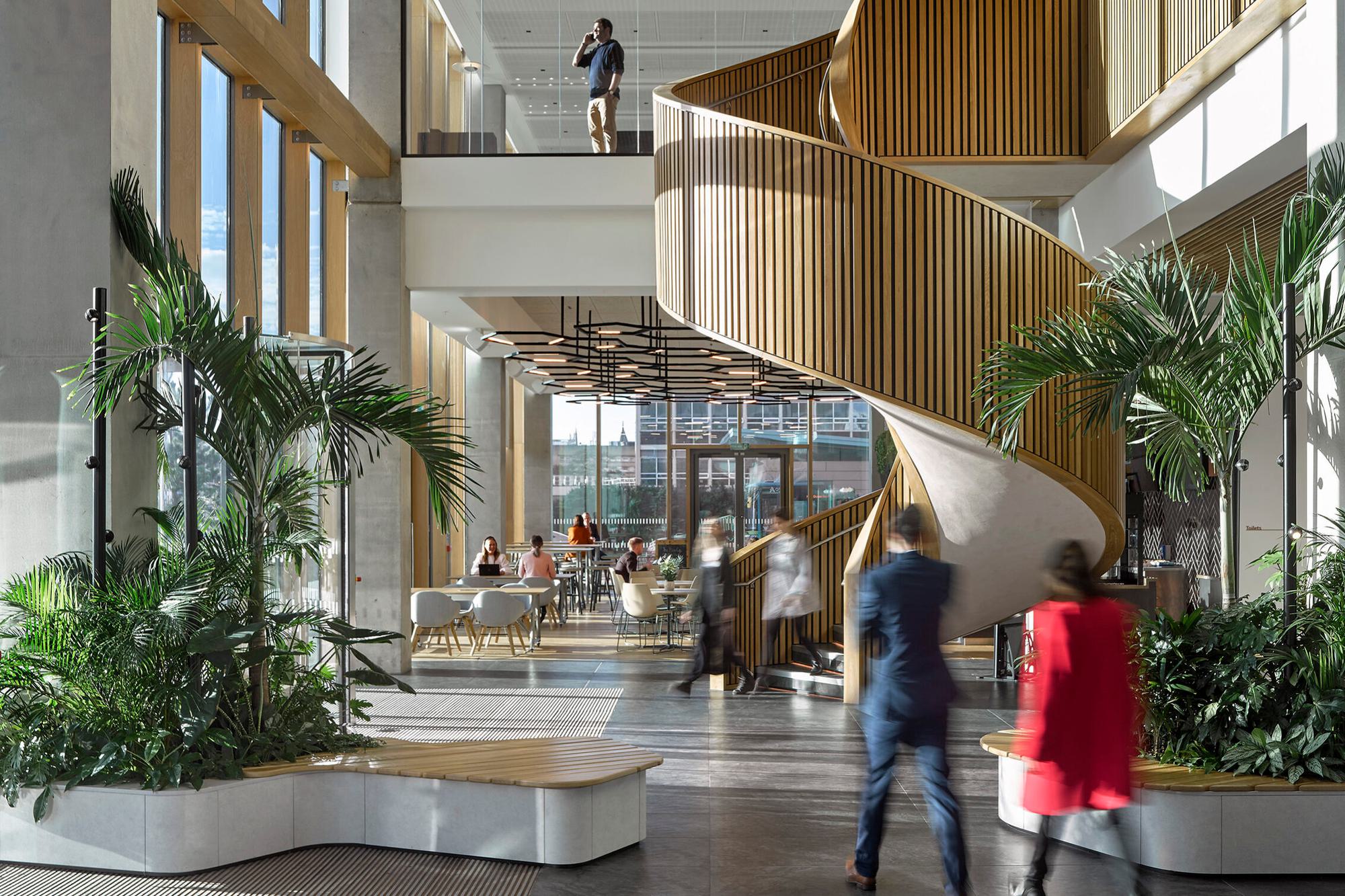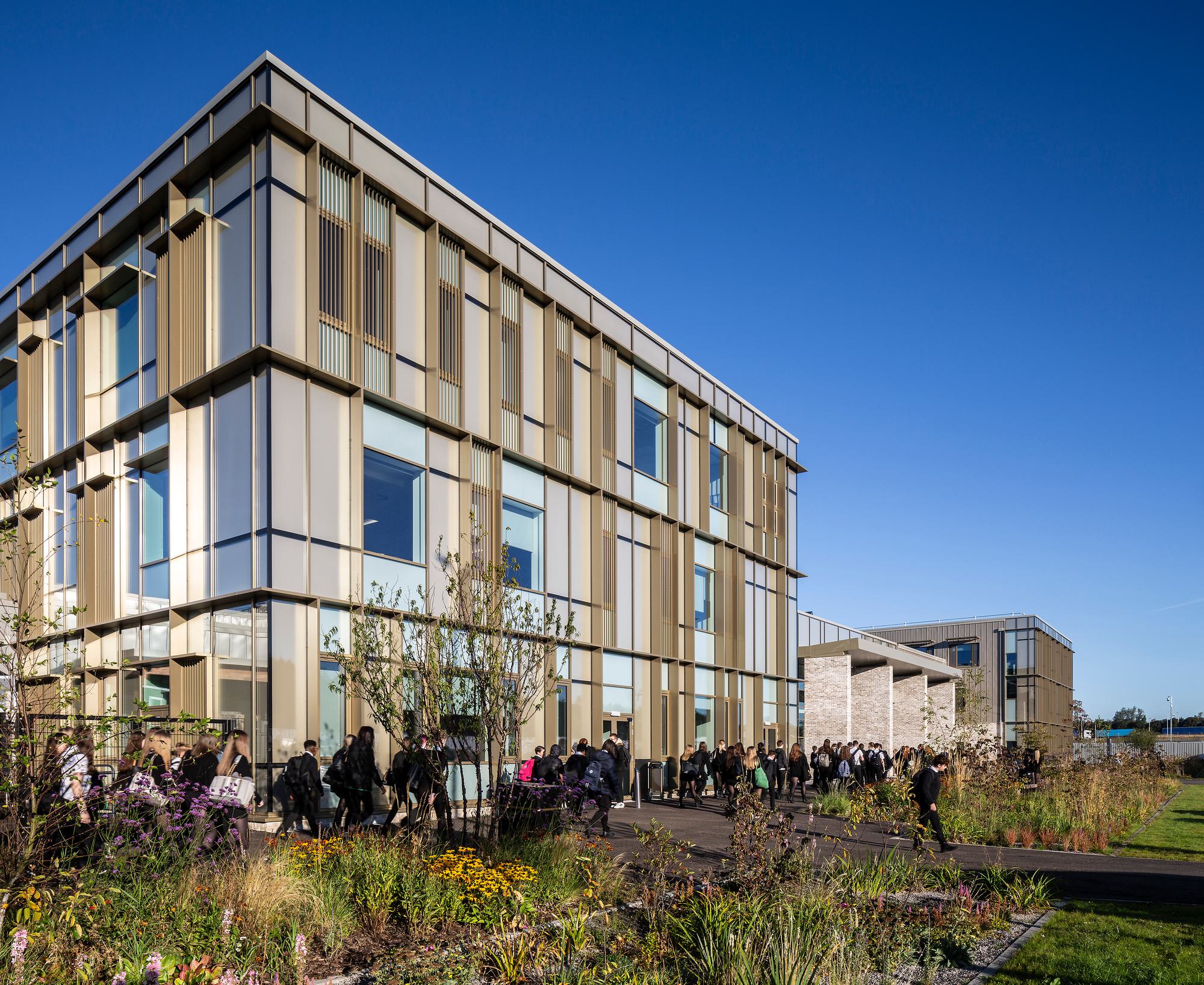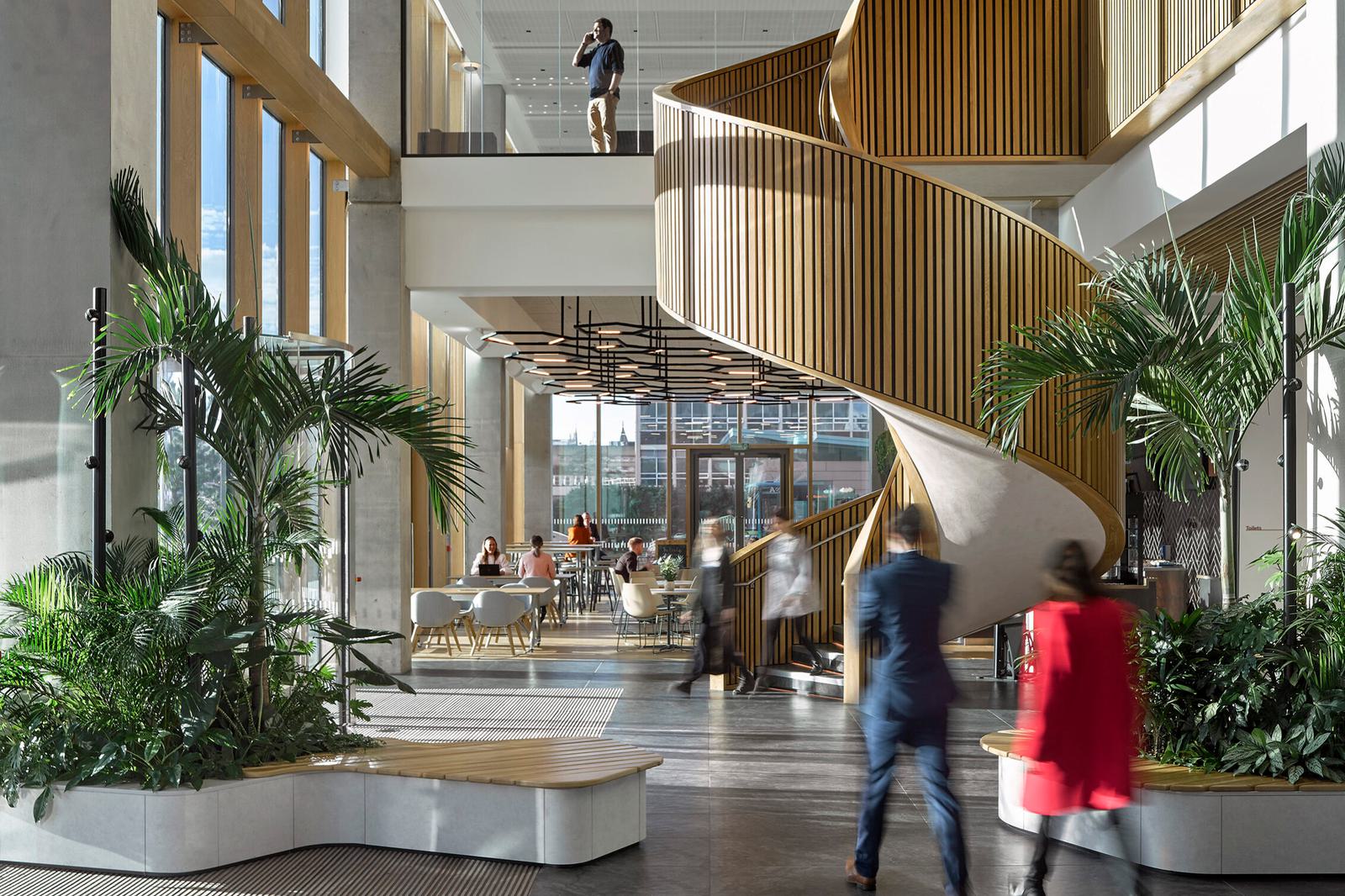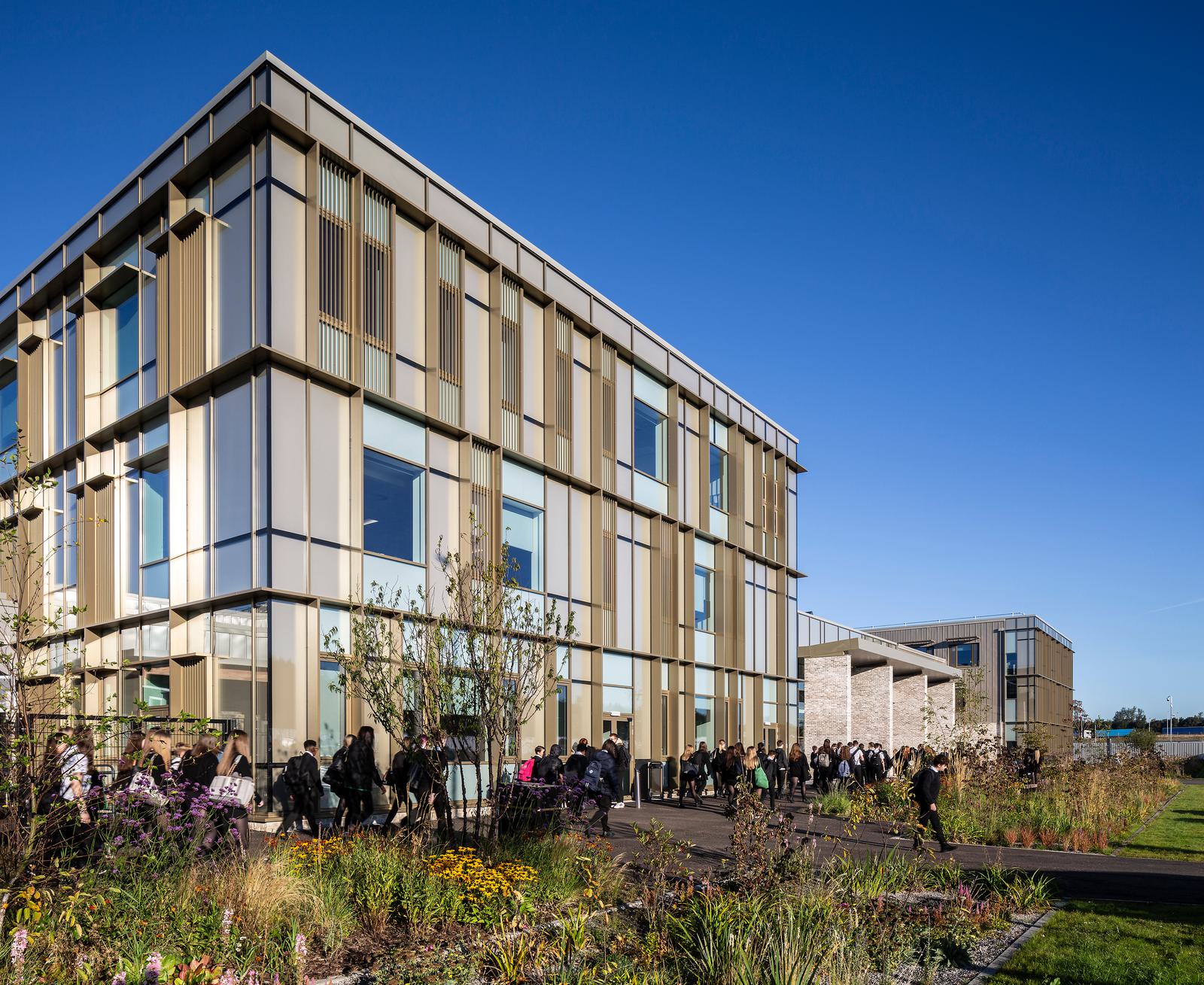
Practice News
Building a sustainable future: Decarbonisation, healthy design and collaboration
by AHR
We recently gathered with industry professionals again in Glasgow to explore the pressing topics of decarbonisation, sustainability and the principles behind designing healthy buildings.
Set in a collaborative setting that encouraged open and forward-thinking conversations, the event brought together key stakeholders from diverse sectors.
Together, we explored the role of healthy building design in driving positive outcomes, actionable decarbonisation strategies and balancing short-term goals with long-term ambitions.
Read on for more.
1. Healthy and inclusive building design
Our discussions naturally began with the question, what do we really mean when we say “healthy buildings?” We focused on healthy building design principles, drawing inspiration from successful projects like The Spine, Woodmill and St Columba’s RC High School and the Daphne Steele Building. Healthy buildings go beyond mere aesthetics. They prioritise the wellbeing of occupants by:
- Improving air quality: Clean air is essential to health and productivity. Enhanced filtration systems, like those in The Spine, significantly reduce pollutants, resulting in fewer illnesses and improved cognitive performance. Studies show that improving air quality can boost mental performance by up to 20%, proving that feeling better leads to working better.
- Incorporating biophilic design: By integrating natural materials, daylight and connections to nature, we support mental wellbeing and cognitive function. By bringing the outdoors in, we can shape calm, productive spaces which have a profound impact on how people feel and function daily.
More positively, designing for health doesn’t always require significant cost increases. Thoughtful decisions early in the process can maximise value without significant increases in budget.
By improving air quality, embracing nature and making intentional design choices early, healthy buildings create spaces that support people and the planet. These principles, as seen in The Spine and other projects, show how thoughtful design can enrich lives, proving that wellness-focused environments are both practical and impactful.
2. How are we approaching the practical steps for decarbonisation?
We also acknowledged the urgency of the climate crisis. Recent data reveals that temperatures are rising faster than anticipated, making it crucial to accelerate our progress towards net zero carbon goals. While challenging, this situation presents an opportunity to significantly enhance our efforts across all sectors.
To achieve this, we must prioritise practical steps towards decarbonisation while ensuring that buildings remain healthy environments for people who use them. This involves aligning design with emerging regulations and integrating sustainability from the very beginning of projects.
We discussed the importance of evidence-based design and the use of tools like science-based methodologies. These approaches support the creation of buildings that meet or exceed sustainability benchmarks, such as Passivhaus standards. Key examples include enhanced insulation and ventilation systems, designed to optimise energy efficiency. By grounding every decision in robust data, we can ensure real and impactful change.
3. Circular economy, smart monitoring and future standards
The principles of the circular economy were also emphasised throughout the conversation. We need to consider the entire lifecycle of materials, from their manufacturing to their disposal and potential reuse, while ensuring that healthy building principles are upheld. By designing with deconstruction, recyclability and wellbeing in mind, materials can be reintroduced into the supply chain, reducing waste, the demand for new resources, and potential harm to indoor environments.
Participants highlighted innovative examples, such as modular construction systems, which not only allow components to be disassembled and repurposed but also contribute to healthier buildings by reducing the need for disruptive renovations and supporting better air quality during the building’s lifecycle. Sustainable design doesn’t end with construction; it’s about ensuring materials have a future beyond their initial use while supporting peoples’ health and wellbeing.
4. Balancing short-term needs with long-term goals
A recurring theme throughout the discussion was the balance between addressing immediate operational needs and planning for long-term sustainability. While financial constraints often pose challenges, participants agreed that taking incremental steps can drive meaningful progress over time and contribute to healthier buildings.
Innovative technologies, such as retrofit toolkits, were recognised as valuable resources. These tools offer early-stage feasibility insights, bridging the gap between ambition and practicality with workable solutions. For example, our retrofit toolkit provides real-time, actionable insights to support informed decision-making at the earliest stages of a project. Discover more here.The use of sensors and analytics to monitor energy use and air quality in existing buildings was highlighted as a practical step towards optimising performance and improving occupant health, which is integral to the concept of healthy buildings. Sensors provide real-time insights, allowing for dynamic adjustments to building systems, ultimately creating spaces that are both sustainable and supportive of wellbeing.
The group collectively agreed that taking immediate, small-scale actions—like improving M&E systems or enhancing insulation—not only generates substantial long-term benefits but also supports healthier indoor environments.
5. Collaboration and unified standards
Our shared goal of decarbonisation is best achieved through collaborative efforts, which also play a pivotal role in creating healthier buildings. Early engagement with experts helps us align our work with sustainability objectives from the start while integrating features that enhance occupant wellbeing.
A few examples of effective collaboration included early multidisciplinary workshops, which bring together architects, engineers and sustainability consultants early on in the project lifecycle to develop holistic designs. These designs not only prioritise energy efficiency but also incorporate wellness-focused elements, ensuring that the outcomes promote both sustainability and health. When the entire team understands these dual goals from the beginning, the process becomes much easier.
There’s also shared data platforms, which allow stakeholders to access real-time project data, enabling more transparent decision-making and reducing inefficiencies. For instance, sharing insights on embodied carbon data for materials helped project teams make more informed material selections that contribute to healthier and more sustainable environments.
Adopting unified standards like the UK Net Zero Carbon Standard ensures consistency across projects and streamlines efforts. Participants praised the framework for providing a clear roadmap for both short-term milestones and long-term goals, with health and sustainability at its core.
Engaging in collaborative industry efforts, such as pilot programs testing decarbonisation methods or regional retrofitting projects, was highlighted as a way to share successes and scale effective practices. By working together, we not only innovate faster but also create templates for healthier, more sustainable buildings that others can follow.
6. Reflections and the path forward
The event highlighted the need for a cultural shift to challenge entrenched decision-making practices that prioritise short-term savings over sustainability. Participants called for:
- Emphasising the moral imperative: Of decarbonisation and wellness as integral to every building’s design and use.- Greater use of post-occupancy evaluations: To refine and validate the benefits of sustainable and healthy design. Evidence builds trust and drives momentum.
- Ongoing collaboration: To share knowledge and accelerate progress.
By leveraging innovation, unified standards and a shared sense of responsibility, the industry can create a sustainable future that benefits both people and the planet.
To learn more about how we are achieving decarbonisation through innovative strategies, visit our perspectives page here.
Posted on:
Jan 27th 2025
Topics:
Share on
Related Articles

Practice News
Celebrating Rob's new appointment as Visiting Professor at Manchester School of Architecture
We’re delighted to share news of director and head of sustainability Robert Hopkin’s appointment as a Visiting Professor at the Manchester School of Architecture (MSA).
Date: 16 Jan 25
by AHR

Thought Leadership
Boosting university income streams through collaborations with developers and local authorities
Universities face mounting financial pressures, many are turning to strategic partnerships with local authorities and private-sector developers.
Date: 31 Mar 25
by AHR

Practice News
Decarbonisation and healthy buildings: Insights from our roundtable discussion in Liverpool
We recently gathered again in Liverpool with industry professionals to explore the pressing topics of decarbonisation, sustainability and the principles behind designing healthy buildings.
Date: 14 Jan 25
by AHR
Practice News
Insights from Manchester: A collaborative approach towards decarbonisation
Six months on from our last session in Manchester, it was a pleasure to gather once again with industry professionals to explore practical pathways towards healthier, more sustainable buildings.
Date: 25 Nov 24







